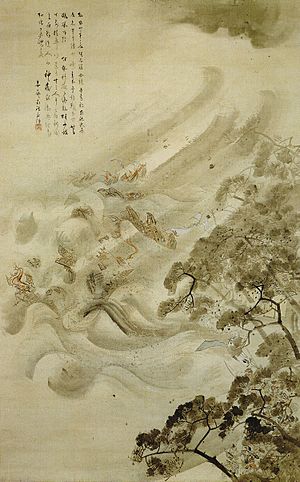Kamikaze (typhoon) facts for kids

The kamikaze (Japanese: 神風, meaning "divine wind") refers to two powerful storms. These storms are believed to have protected Japan from two large Mongol fleets. These fleets were led by Kublai Khan and attacked Japan in 1274 and again in 1281.
At that time, Zen Buddhism was growing among the Samurai. Because of this, these storms were called "divine wind." This name came from both their perfect timing and their great power. The word kamikaze has been used in Japanese poetry for a long time.
The term "kamikaze" is one way to read the Kanji characters. The more common historical reading was "shinpu."
Contents
History of the Mongol Invasions
The second Mongol fleet was very large. It had "more than four thousand ships carrying nearly 140,000 men." Some people say it was the biggest naval invasion ever attempted until modern times. For example, the D-Day invasion in 1944 was larger.
The Kamikaze Events
In the first invasion, the Mongols successfully took over Tsushima and Iki islands. These are small islands near Japan. When they landed at Hakata Bay in Japan, they faced strong resistance. Japanese samurai armies fought bravely against them. The Mongols were forced to go back to their bases in China.
As they were leaving, a powerful typhoon hit their fleet. Many of their ships sank, and many soldiers drowned. This first storm happened in the autumn of 1274. The Mongol fleet had 500 to 900 ships and 30,000 to 40,000 men. The typhoon struck while they were in Hakata Bay. About 13,000 men drowned, and around one-third of their ships sank. The remaining ships were badly damaged.
Between the first and second invasions, the Japanese were smart. They built strong walls, two meters high, to protect their coast. These walls would help defend against future attacks.
Seven years later, the Mongols returned with an even bigger fleet. Because of the new walls, they could not find good places to land their ships. The fleet had to stay at sea for months. Their supplies ran low as they searched for a landing spot. After being exposed to the harsh weather for a long time, the fleet was destroyed. A huge typhoon hit them, which the Japanese called "kamikaze" (divine wind).

The Mongols never attacked Japan again after this. It is said that more than 70,000 Mongol soldiers were captured. The second fleet was much larger. It had two forces with an estimated total of 4,400 ships and 140,000 men. This greatly outnumbered the Japanese soldiers, who had about 40,000 samurai and other fighters. The typhoon caused at least half of the Mongol men to die. Only a few hundred vessels survived the storm. Most of the survivors were later killed by the Japanese. This event is seen as one of the biggest and most disastrous naval invasion attempts in history.
Kamikaze in Myth
In popular Japanese stories from that time, the god Raijin was often said to be the one who turned the storms against the Mongols. Other myths say that the gods Fūjin, Ryūjin, or Hachiman caused the destructive kamikaze winds.
Kamikaze as a Metaphor
The name given to the storm, kamikaze, was used again much later. During World War II, it became a metaphor for nationalist propaganda. It was used for Japanese pilots who bravely flew their planes to try and stop the enemy. The idea was that these pilots would be the "Divine Wind" that would once again sweep the enemy from the seas. This later use of kamikaze is now the most common meaning of the word in English.
See also
- Act of God
- Battle of Bun'ei
- Battle of Kōan
- Divine providence
- Mongol invasions of Japan
- Protestant Wind
- Boreas
- Miracle of the House of Brandenburg
- Theodicy
- Tornado

